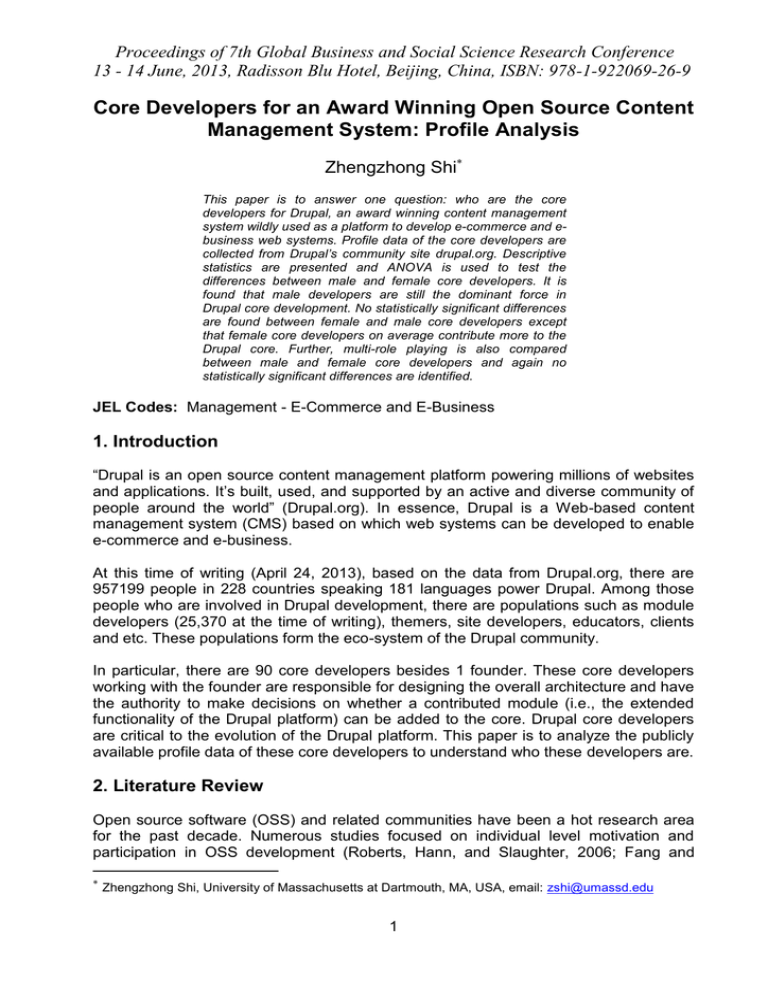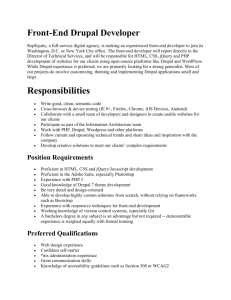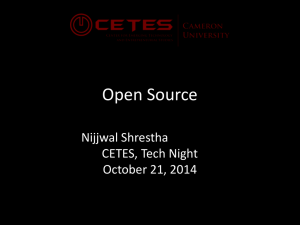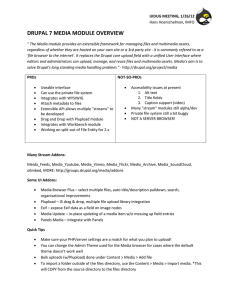Proceedings of 7th Global Business and Social Science Research Conference
advertisement

Proceedings of 7th Global Business and Social Science Research Conference 13 - 14 June, 2013, Radisson Blu Hotel, Beijing, China, ISBN: 978-1-922069-26-9 Core Developers for an Award Winning Open Source Content Management System: Profile Analysis Zhengzhong Shi This paper is to answer one question: who are the core developers for Drupal, an award winning content management system wildly used as a platform to develop e-commerce and ebusiness web systems. Profile data of the core developers are collected from Drupal’s community site drupal.org. Descriptive statistics are presented and ANOVA is used to test the differences between male and female core developers. It is found that male developers are still the dominant force in Drupal core development. No statistically significant differences are found between female and male core developers except that female core developers on average contribute more to the Drupal core. Further, multi-role playing is also compared between male and female core developers and again no statistically significant differences are identified. JEL Codes: Management - E-Commerce and E-Business 1. Introduction “Drupal is an open source content management platform powering millions of websites and applications. It’s built, used, and supported by an active and diverse community of people around the world” (Drupal.org). In essence, Drupal is a Web-based content management system (CMS) based on which web systems can be developed to enable e-commerce and e-business. At this time of writing (April 24, 2013), based on the data from Drupal.org, there are 957199 people in 228 countries speaking 181 languages power Drupal. Among those people who are involved in Drupal development, there are populations such as module developers (25,370 at the time of writing), themers, site developers, educators, clients and etc. These populations form the eco-system of the Drupal community. In particular, there are 90 core developers besides 1 founder. These core developers working with the founder are responsible for designing the overall architecture and have the authority to make decisions on whether a contributed module (i.e., the extended functionality of the Drupal platform) can be added to the core. Drupal core developers are critical to the evolution of the Drupal platform. This paper is to analyze the publicly available profile data of these core developers to understand who these developers are. 2. Literature Review Open source software (OSS) and related communities have been a hot research area for the past decade. Numerous studies focused on individual level motivation and participation in OSS development (Roberts, Hann, and Slaughter, 2006; Fang and Zhengzhong Shi, University of Massachusetts at Dartmouth, MA, USA, email: zshi@umassd.edu 1 Proceedings of 7th Global Business and Social Science Research Conference 13 - 14 June, 2013, Radisson Blu Hotel, Beijing, China, ISBN: 978-1-922069-26-9 Neufeld, 2009; Wu, Gerlach, and Young 2007; Hahn, Moon, and Zhang, 2008; Li, Tan, and Teo, 2012). In addition, commercial companies were also found to contribute to the OSS development (Andersen-Gott, Ghinea, and Bygstad, 2012). Further, factors impacting OSS project success have also been explored. For example, Stewart and Gosain (2006) investigated how OSS community values, norms, and beliefs influence OSS project effectiveness in terms of attracting and retaining team members and guiding project development towards success. This current paper is to follow these lines of thinking and to identify who are the core developers for Drupal through profile data collection and analysis with the goal of laying the foundation for future research on why as an OSS Drupal is such a successful story to ultimately advance our knowledge of OSS success factors. 3. The Methodology Evolution of Drupal: Dries Buytaert is the founder of Drupal and he has 21486 commits to Drupal core (11062 commits) and other 134 modules by the time profile data collection was completed. In his blog (http://buytaert.net/), he describes himself as “the original creator and project lead of Drupal, an open source social publishing system. He is co-founder and chief technology officer of Acquia, a venture-backed software company that offers products and services for Drupal.” Until this time to writing, Drupal has seven stable major core releases and Drupal 8 is actively under development. Figure 1 demonstrates the evolution of 5 major releases (data are available only for Drupal, 4, 5, 6, 7 and 8). The numbers on the vertical axis are used to represent different major and minor releases with higher level releases having a larger number. Appendix A has all the detailed data on all major and minor releases since Drupal 4.7. Data Collection: Drupal community site (drupal.org) is used as the source to collect profile data for those Drupal core developers. All the profile data can be accessed at http://drupal.org/node/3060/committers. Since these developers continuously make commits to the core and we can only take a snapshot of their profiles. Profile data were collected within one day in April 2013. Profile data include responses to the questions listed in Table 1. Information such as name, gender, country of citizenship, and other bio information may also be provided by these developers. 2 Proceedings of 7th Global Business and Social Science Research Conference 13 - 14 June, 2013, Radisson Blu Hotel, Beijing, China, ISBN: 978-1-922069-26-9 Table 1: Profile Questions on Drupal.org 1. I contributed Drupal patches 2. I contributed Drupal modules 3. I contributed Drupal themes 4. I contributed Drupal installation profiles 5. I contributed to Drupal issue queues 6. I contributed Drupal documentation 7. I contributed Drupal translations 8. I contributed Drupal automated tests 9. I reviewed Project applications 10. I help in the Drupal support forums 11. I provide Drupal-related services 12. I give support on IRC 13. I help mentor new contributors 14. Conferences attended Data Analysis and Results: Table 2 lists countries from which Drupal core developers are coming. US has 31 members (34.4%) and Germany and UK have 8 (8.9%) and 7(7.8%) respectively. Belgium and Canada have 6 (6.7%) developers each. Clearly, core developers are mostly from developed countries. Table 3 lists gender distribution and it is found that male developers (71, 78.9%) are still the dominant force among core developers. However, one female member (webchick http://drupal.org/user/24967, http://www.webchick.net/) plays a major role in Drupal development. She is the comaintainer for Drupal core. She has 4616 commits to Drupal core and 8274 commits in total and covers 79 modules besides Drupal core. Table 2: Country Distribution of Drupal Core Developers Country Number of Contributors Percentage US 31 34.4% Germany 8 8.9% UK 7 7.8% Belgium 6 6.7% Canada 6 6.7% France 4 4.4% Spain 4 4.4% Russian Fed 3 3.3% Unspecified 3 3.3% Hungary 2 2.2% Sweden 2 2.2% Switzerland 2 2.2% Argentina, Australia, Austria, Costa Rica, Denmark, Hungary, Japan, Mexico, Netherlands, Norway, Romania, Serbia, and Slovenia have 1 member involved in Drupal core development. (Founder is not included) Total 90 100% Note: There are 44 (48.9%) contributors who are members of Drupal Association. 3 Proceedings of 7th Global Business and Social Science Research Conference 13 - 14 June, 2013, Radisson Blu Hotel, Beijing, China, ISBN: 978-1-922069-26-9 Table 3: Gender Distribution Number of Gender Contributors Female 7 Male 71 Unspecified 12 Total 90 Percentage 7.8% 78.9% 13.3% 100% Table 4: Descriptive Statistics of Male and Female Core Developers Number of Weeks Commits Total Projects Gender since Registering with to Core Commits Covered Drupal Community Site 312.1 743.0 1571.4 30.0 Mean 7.0 7.0 7.0 7.0 N Female Std. 67.7 1707.6 2966.6 24.1 Deviation 300.2 92.5 1010.1 34.2 Mean 71.0 71.0 71.0 71.0 N Male Std. 124.7 289.9 1508.5 31.4 Deviation 301.3 150.8 1060.5 33.8 Mean Total N Std. Deviation 78.0 78.0 78.0 78.0 120.4 581.9 1667.5 30.7 Table 5: Comparison between Male and Female Core Developers weeks * Gender Between Groups Commits to Core * Gender Total Commits * Gender Projects Covered * Gender Within Groups Total Between Groups Within Groups Total Between Groups Within Groups Total Between Groups Within Groups Total (Combined) df 1.0 F .1 Sig. .804 (Combined) 76.0 77.0 1.0 8.8 .004 (Combined) 76.0 77.0 1.0 .7 .399 (Combined) 76.0 77.0 1.0 .1 .732 76.0 77.0 4 Proceedings of 7th Global Business and Social Science Research Conference 13 - 14 June, 2013, Radisson Blu Hotel, Beijing, China, ISBN: 978-1-922069-26-9 From Tables 4 and 5 above, based on ANOVA test, it is found that male and female members are not statistically different from each other in terms of average number of weeks since registering with Drupal.org, total commits, and number of projects covered. However, in terms of commits to Drupal core, female core developers on average contribute more compared with male developers. Tables 6 and 7 present descriptive statistics about core developers’ involvement in module development, theme development, and educational activities. Module development involvement is reflected on whether the member is involved in patch contribution to existing modules, new module development, issue queue contribution, project translation, project application review, participation of module test, and development of installation profiles. Educational involvement is reflected by whether the developer participates in forum discussions and Internet Relay Chat (IRC) communications, the number of conference attended, and documentation contribution. Theme development involvement is based on one question in the profile page. Table 6: Module Development Involvement Comparison: Female vs. Male Gender Drupal Association Membership Patches Modules Installation Profiles Issue Queue Translation automated test Reviewed project applications Female 5 6 6 1 7 1 5 1 Percentage (out of 7) 71% 86% 86% 14% 100% 14% 71% 14% Male 35 63 60 12 43 18 35 18 Percentage (out of 71) 49% 89% 85% 17% 61% 25% 49% 25% Table 7: Educational Activity and Theme Development Involvement Educational Activity Involvement Gender forum IRC mentor new contributors Average Number of Attended Conferences until 2013 April Female 2 5 2 6.7 Percentage (out of 7) 28.6% 71.4% 28.6% 95.7% Male 24 41 14 3.6 Percentage (out of 71) 34% 58% 20% 5% 5 Average of documentation commits 368.6 Theme Development Involvement 2 28.6% 26.9 15 21% Proceedings of 7th Global Business and Social Science Research Conference 13 - 14 June, 2013, Radisson Blu Hotel, Beijing, China, ISBN: 978-1-922069-26-9 In order to understand the levels of involvement for female and male core developers in various community activities listed in Tables 6 and 7, overall module development involvement score, educational involvement score, and the multi-role playing score are calculated. Specifically, multi-role play is included since it has been found to be positively associated with OSS success and innovativeness (Daniel et al. 2012). First, if a developer is involved in one of those module development activities as presented in Table 6, he/she will earn one point for module development involvement. The formula used to calculate the overall individual module development involvement score is sum of involvement in those 7 activities / 7*10. Second, the individual theme design involvement score is derived by checking one question in the profile page. The formula used is theme design involvement*10. Theme design involvement score will be 10 if the core developer is indeed involved with theme development. Third, individual education involvement score is calculated by checking whether the core developer participates in forum discussions and Internet Relay Chat (IRC) communications, whether he/she mentors new members, and the extent of conference participation (i.e., the number of conference attended/the number of conferences available by the sampling date), and documentation contribution (i.e., each individual’s commits/maximal number of commits by a core developer). The formula used is sum of involvement of the 5 educational activities/5 *10. The individual multi-role playing score is calculated by using the formula: Module Development Involvement*Theme Development Involvement + Module Development Involvement *Education involvement + Theme Development Involvement *Education involvement. Table 8 shows the average scores of educational, module development, and theme development involvement and the average score of multi-role playing for male and female core developers. Table 9 presents ANOVA test results on whether there are statistically significant differences between female and male core developers in getting involved in educational activities, module development, theme development activities, and the multi-role playing. It is found that there are no differences between male and female core developers in educational, module development, and overall multi-role playing activity involvement. Table 8: Multi-role Playing, Educational, and Module Development Involvement Descriptive Statistics Female Male Total Multi-Role Play 60.26 Educational Involvement 4.16 Module Development Involvement 5.51 Theme Development Involvement 2.86 N 7.00 7.00 7.00 7.00 Std. Deviation 93.73 3.06 1.92 4.88 Mean 37.96 2.81 5.01 2.11 N 71.00 71.00 71.00 71.00 Std. Deviation 56.14 2.11 2.36 4.11 Mean 39.97 2.90 5.05 2.18 N 78.00 79.00 78.00 78.00 Std. Deviation 59.93 2.23 2.32 4.16 Gender Mean 6 Proceedings of 7th Global Business and Social Science Research Conference 13 - 14 June, 2013, Radisson Blu Hotel, Beijing, China, ISBN: 978-1-922069-26-9 Table 9: ANOVA Test: Multi-role Playing, Educational Involvement, Module Development Involvement, and Theme Development: Male Vs. Female Core Developers Multi-RolePlay * Gender Educational Involvement * Gender Module Development Involvement * Gender Theme Development Involvement * Gender Between Groups (Combined) df 1 Within Groups 76 Total Between Groups (Combined) Within Groups Total Between Groups (Combined) 77 2 76 78 1 Within Groups Total 76 77 Between Groups (Combined) 1 Within Groups 76 Total 77 F .880 Sig. .351 1.892 .158 .294 .589 .202 .654 4. Findings Through profile data analysis, it is found that the majority of Drupal core developers are coming from developed countries and especially from US. It is also found that female core developers are not different from their male co-developers in terms of average number of weeks since registering with Drupal.org, overall total commits, and the number of projects covered. However, in terms of commits to the Drupal core, female core developers, on average, indeed contribute more compared with male core developers. Third, no statistically significant differences are identified between male and female core developers in getting involved in module development, theme development, and educational activities. Lastly, for multi-role playing, no significant difference is found either. 5. Summary and Conclusions In this paper, profile data of core developers of Drupal are collected from the Drupal community site Drupal.org. Descriptive statistics are presented and ANOVA tests are used to identify any differences between male and female core developers in terms of their involvement in Drupal community. These tests demonstrate that while male core developers are still the dominant force for Drupal core development, female developers who do get involved in core development activities perform equally well. Findings in this paper related to core developers in general and comparisons between male and female core developers in particular lay a foundation for future study of success factors for Drupal - the award winning content management system. This line of research will help advance our knowledge about success factors for open source software in general in an accumulative manner. 7 Proceedings of 7th Global Business and Social Science Research Conference 13 - 14 June, 2013, Radisson Blu Hotel, Beijing, China, ISBN: 978-1-922069-26-9 References Andersen-Gott, Morten, Gheorghita Ghinea, and Bendik Bygstad. 2012, “Why Do Commercial Companies Contribute to Open Source Software?” International Journal of Information Management, Volume 32, Issue 2, Pages 106-117. Daniel, S, R. Agarwal, and K. J. Stewart. 2012, “The Effects of Diversity in Global, Distributed Collectives: A study of Open Source project Success”. Information Systems Research, Articles in Advance, pp. 1-22. ISSN 1047-7047 (print) ISSN 1526-5536 (online). Fang, Y. and D. Neufeld, 2009, “Understanding Sustained Participation in Open Source Software Projects.” Journal of Management Information Systems, Vol. 25, No.4, pp. 9-50. Hahn, J., J. Y. Moon, and C. Zhang, 2008, “Emergence of New Project Teams from Open Source Software Developer Networks: Impact of Prior Collaboration Ties.” Information Systems Research, Vol. 19, No. 3, pp. 369-391. Li, Yan, Chuan-Hoo Tan, and Hock-Hai Teo. 2012, “Leadership Characteristics and Developers’ Motivation in Open Source Software Development”. Information & Management, Volume 49, Issue 5, Pages 257-267. Roberts, J., I. Hann, and S. Slaughter, 2006, “Understanding the Motivations, Participation, and Performance of Open Source Software Developers: a Longitudinal Study of the Apache Projects.” Management Science, Vol. 52, No. 7, pp. 984-999. Stewart, J. K. and S. Gosain, 2006, “The Impact of Ideology on Effectiveness in Open Source Software development Teams.” MIS Quarterly, Vol. 30, No. 2, pp. 291314. Wu, Chorng-Guang, James H. Gerlach, Clifford E. Young, 2007, “An Empirical Analysis of Open Source Software Developers’ Motivations and Continuance Intentions”. Information & Management, Volume 44, Issue 3, Pages 253-262. 8 Proceedings of 7th Global Business and Social Science Research Conference 13 - 14 June, 2013, Radisson Blu Hotel, Beijing, China, ISBN: 978-1-922069-26-9 February 21, 2010 87 alpha5 drupal 7.0alpha4 drupal 7.0alpha3 drupal 7.0alpha2 drupal 7.0alpha1 Drupal 7.xdev drupal 6.28 86 drupal 6.27 December 19, 2012 85 84 83 82 81 80 79 78 77 76 75 74 drupal 6.26 drupal 6.25 drupal 6.24 drupal 6.23 drupal 6.22 drupal 6.21 drupal 6.20 drupal 6.19 drupal 6.18 drupal 6.17 drupal 6.16 drupal 6.15 73 drupal 6.14 72 71 70 69 68 67 66 65 64 63 62 61 60 59 drupal 6.13 drupal 6.12 drupal 6.11 drupal 6.10 drupal 6.9 drupal 6.8 drupal 6.7 drupal 6.6 drupal 6.5 drupal 6.4 drupal 6.3 drupal 6.2 drupal 6.1 drupal 6.0 drupal 6.0rc4 drupal 6.0rc3 drupal 6.0rc2 drupal 6.0rc1 May 2, 2012 February 29, 2012 February 1, 2012 February 1, 2012 May 25, 2011 May 25, 2011 December 15, 2010 August 11, 2010 August 11, 2010 June 2, 2010 March 4, 2010 December 16, 2009 September 16, 2009 July 1, 2009 May 13, 2009 April 30, 2009 February 25, 2009 January 14, 2009 December 11, 2008 December 10, 2008 October 22, 2008 October 8, 2008 August 14, 2008 July 9, 2008 April 9, 2008 February 27, 2008 February 13, 2008 Appendix: Drupal Releases 92 Assigned Version Number for Graphing 126 125 124 123 122 121 120 119 118 117 116 115 114 113 112 111 110 109 108 107 106 105 104 103 102 101 100 99 98 97 96 95 94 93 Release 91 Initial Post Date 90 Drupal 8.xdev drupal 7.22 drupal 7.21 drupal 7.20 drupal 7.19 drupal 7.18 drupal 7.17 drupal 7.16 drupal 7.15 drupal 7.14 drupal 7.13 drupal 7.12 drupal 7.11 drupal 7.10 drupal 7.9 drupal 7.8 drupal 7.7 drupal 7.6 drupal 7.5 drupal 7.4 drupal 7.3 drupal 7.2 drupal 7.1 drupal 7.0 drupal 7.0rc4 drupal 7.0rc3 drupal 7.0rc2 drupal 7.0rc1 drupal 7.0beta3 drupal 7.0beta2 drupal 7.0beta1 drupal 7.0alpha7 drupal 7.0alpha6 drupal 7.0- September 9, 2009 89 April 3, 2013 March 7, 2013 February 20, 2013 January 16, 2013 December 19, 2012 November 7, 2012 October 17, 2012 August 1, 2012 May 2, 2012 May 2, 2012 February 1, 2012 February 1, 2012 December 5, 2011 October 26, 2011 August 31, 2011 July 28, 2011 July 27, 2011 July 27, 2011 June 30, 2011 June 30, 2011 May 25, 2011 May 25, 2011 January 5, 2011 88 December 30, 2010 December 23, 2010 December 11, 2010 December 1, 2010 November 14, 2010 October 23, 2010 58 October 7, 2010 57 September 16, 2010 56 July 9, 2010 55 May 23, 2010 9 April 26, 2010 March 21, 2010 January 15, 2010 July 2, 2008 January 16, 2013 February 8, 2008 January 30, 2008 January 10, 2008 December 20, 2007 Proceedings of 7th Global Business and Social Science Research Conference 13 - 14 June, 2013, Radisson Blu Hotel, Beijing, China, ISBN: 978-1-922069-26-9 49 48 47 drupal 6.0beta4 drupal 6.0beta3 drupal 6.0beta2 drupal 6.0beta1 Drupal 6.xdev Drupal 5.23 Drupal 5.22 Drupal 5.21 46 Drupal 5.20 45 44 43 42 41 40 39 38 37 36 35 34 33 32 31 30 29 28 27 26 Drupal 5.19 Drupal 5.18 Drupal 5.17 Drupal 5.16 Drupal 5.15 Drupal 5.14 Drupal 5.13 Drupal 5.12 Drupal 5.11 Drupal 5.10 Drupal 5.9 Drupal 5.8 Drupal 5.7 Drupal 5.6 Drupal 5.5 Drupal 5.4 Drupal 5.3 Drupal 5.2 Drupal 5.1 Drupal 5.0 Drupal 5.0rc2 Drupal 5.0rc1 Drupal 5.0beta2 Drupal 5.xdev Drupal 5.0beta1 Drupal 4.7.11 Drupal 4.7.10 Drupal 4.7.9 54 53 52 51 50 25 24 23 22 21 20 19 18 September 15, 2007 17 16 15 14 13 12 11 10 Drupal 4.7.8 Drupal 4.7.7 Drupal 4.7.6 Drupal 4.7.5 Drupal 4.7.4 Drupal 4.7.3 Drupal 4.7.2 Drupal 4.7.1 October 17, 2007 July 26, 2007 January 29, 2007 January 5, 2007 October 18, 2006 August 2, 2006 June 2, 2006 May 25, 2006 November 13, 2006 9 Drupal 4.7.0 May 1, 2006 August 11, 2010 March 4, 2010 December 16, 2009 September 16, 2009 July 1, 2009 May 13, 2009 April 30, 2009 February 25, 2009 January 14, 2009 December 11, 2008 December 10, 2008 October 22, 2008 October 8, 2008 August 14, 2008 July 23, 2008 July 9, 2008 January 29, 2008 January 10, 2008 December 6, 2007 December 5, 2007 October 17, 2007 July 26, 2007 January 30, 2007 January 15, 2007 8 December 5, 2007 November 21, 2007 October 17, 2007 7 6 5 4 3 2 1 January 10, 2007 December 15, 2006 November 28, 2006 November 11, 2006 October 31, 2006 January 10, 2008 December 6, 2007 December 5, 2007 10 Drupal 4.7.0-rc4 Drupal 4.7.0-rc3 Drupal 4.7.0-rc2 Drupal 4.7.0-rc1 Drupal 4.7.0-beta6 Drupal 4.7.0-beta5 Drupal 4.7.0-beta4 Drupal 4.7.0-beta3 April 28, 2006 April 15, 2006 April 7, 2006 March 31, 2006 March 14, 2006 March 2, 2006 January 26, 2006 January 9, 2006








